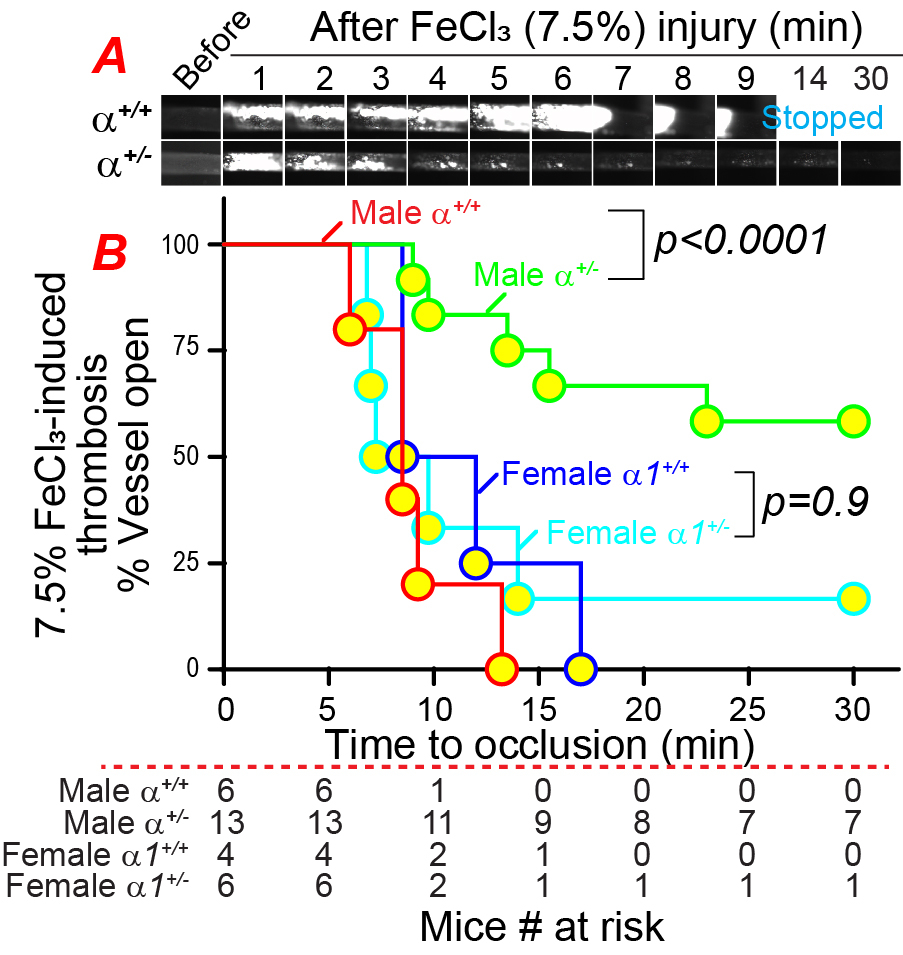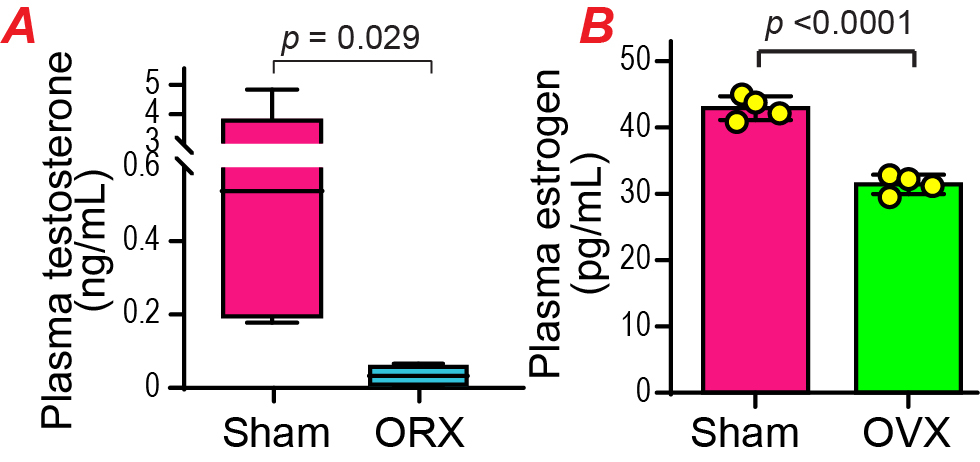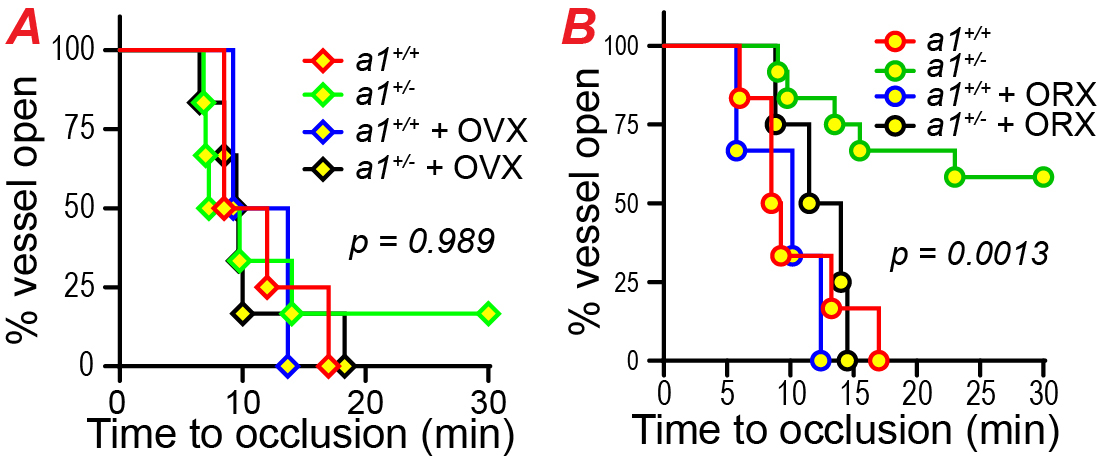Final ID: Sa1005
The role of Na+/K+ ATPase alpha 1 subunit in the sex-difference-associated high risk of thrombosis
Abstract Body (Do not enter title and authors here): Background: Significant sex differences in the risk of thrombosis-related diseases such as myocardial infarction, stroke, and venous thromboembolism have been well documented in clinical studies. However, the mechanism for these differences is unknown. The sodium/potassium ATPase (NKA), comprising α and β subunits, is crucial in maintaining the sodium and potassium gradient across the cell membrane. It is known that estrogen upregulates the expression of the NKA α1 subunit, encoded by the Atp1a1 gene, NKA α1 also acts as the receptor for androgen. We hypothesize that NKA α1 is responsible for the sex difference in the risk of thrombosis.
Methods: Wild-type (WT) and α1 heterozygous (α1+/-) mice of both sexes, aged 8-12 weeks, were subjected to the FeCl3-induced carotid artery injury thrombosis model. WT and α1+/- mice that underwent orchiectomy (ORX) or ovariectomy (OVX) were subjected to the thrombosis study in vivo 8 weeks later. Western blot of platelet lysates was used for mechanistic molecular studies.
Results: WT female mice had a significantly shorter time to form occlusive thrombosis than males. Atp1a1 haplodeficiency significantly inhibited 7.5% FeCl3-induced thrombosis in male but not in female mice (Figure 1). ATP1A1 heterozygosity significantly reduced platelet ATP1A1 expression in male mice without affecting intracellular sodium concentration. Female mice platelets expressed more α1 than males. OVX or ORX significantly reduced plasma estrogen (17-beta-estradiol) and testosterone levels, with gonadectomy-induced hormone changes being more dramatic in males (Figure 2). OVX did not affect thrombosis in female mice, either WT or α1+/- mice. ORX did not affect thrombosis in WT mice; however, it significantly enhanced thrombosis in male α1+/- mice (Figure 3). The expression of platelet ATP1A1 was significantly increased in mice that underwent ORX for 8 weeks or under ovariectomy for 8 weeks followed by treating them with estrogen for 1 week.
Conclusion: ATP1A1 plays an essential role in platelet activation and thrombosis. Both ORX and estrogen treatment significantly increased platelet ATP1A1 expression, consequently diminishing the anti-thrombotic phenotype in the male α1+/- mice. These data suggest that the interaction between NKA α1 and sex hormones plays a pivotal role in thrombosis. Targeting ATP1A1 could be a novel strategy for addressing the sex difference-associated high risk of thrombosis.
Methods: Wild-type (WT) and α1 heterozygous (α1+/-) mice of both sexes, aged 8-12 weeks, were subjected to the FeCl3-induced carotid artery injury thrombosis model. WT and α1+/- mice that underwent orchiectomy (ORX) or ovariectomy (OVX) were subjected to the thrombosis study in vivo 8 weeks later. Western blot of platelet lysates was used for mechanistic molecular studies.
Results: WT female mice had a significantly shorter time to form occlusive thrombosis than males. Atp1a1 haplodeficiency significantly inhibited 7.5% FeCl3-induced thrombosis in male but not in female mice (Figure 1). ATP1A1 heterozygosity significantly reduced platelet ATP1A1 expression in male mice without affecting intracellular sodium concentration. Female mice platelets expressed more α1 than males. OVX or ORX significantly reduced plasma estrogen (17-beta-estradiol) and testosterone levels, with gonadectomy-induced hormone changes being more dramatic in males (Figure 2). OVX did not affect thrombosis in female mice, either WT or α1+/- mice. ORX did not affect thrombosis in WT mice; however, it significantly enhanced thrombosis in male α1+/- mice (Figure 3). The expression of platelet ATP1A1 was significantly increased in mice that underwent ORX for 8 weeks or under ovariectomy for 8 weeks followed by treating them with estrogen for 1 week.
Conclusion: ATP1A1 plays an essential role in platelet activation and thrombosis. Both ORX and estrogen treatment significantly increased platelet ATP1A1 expression, consequently diminishing the anti-thrombotic phenotype in the male α1+/- mice. These data suggest that the interaction between NKA α1 and sex hormones plays a pivotal role in thrombosis. Targeting ATP1A1 could be a novel strategy for addressing the sex difference-associated high risk of thrombosis.
More abstracts on this topic:
A Rare Case of Loeffler Endocarditis and Intracardiac Thrombus in the setting of FIP1L1-PDGFRA Mutation
Shaik Aleesha, Pankayatselvan Varayini, Mazar Michael, Bokhoor Pooya
A sex-specific CD4+ T cell response limits Coxsackievirus B pathogenesis in mice.Robinson Christopher, Pattnaik Aryamav, Dhalech Adeeba, Condotta Stephanie, Corn Caleb, Richer Martin, Snell Laura



